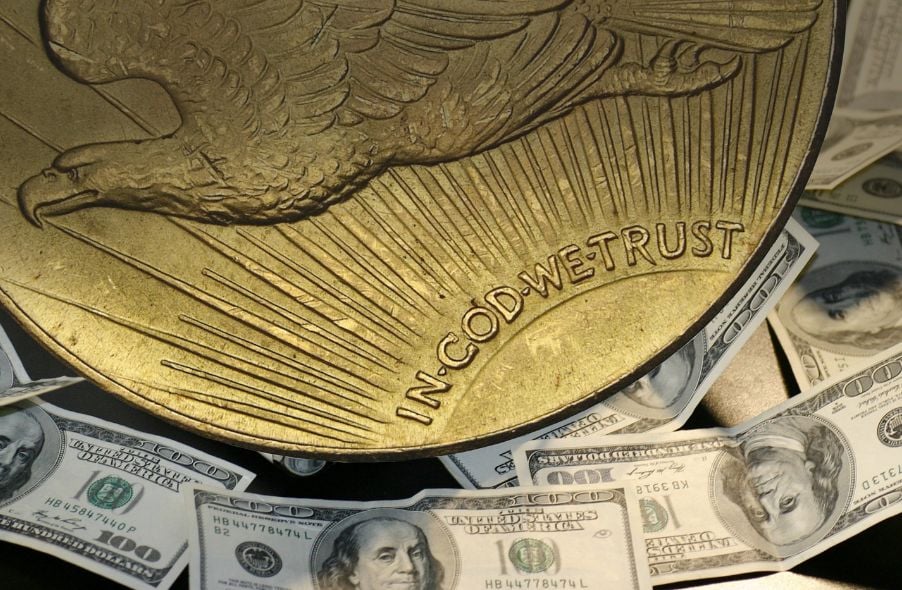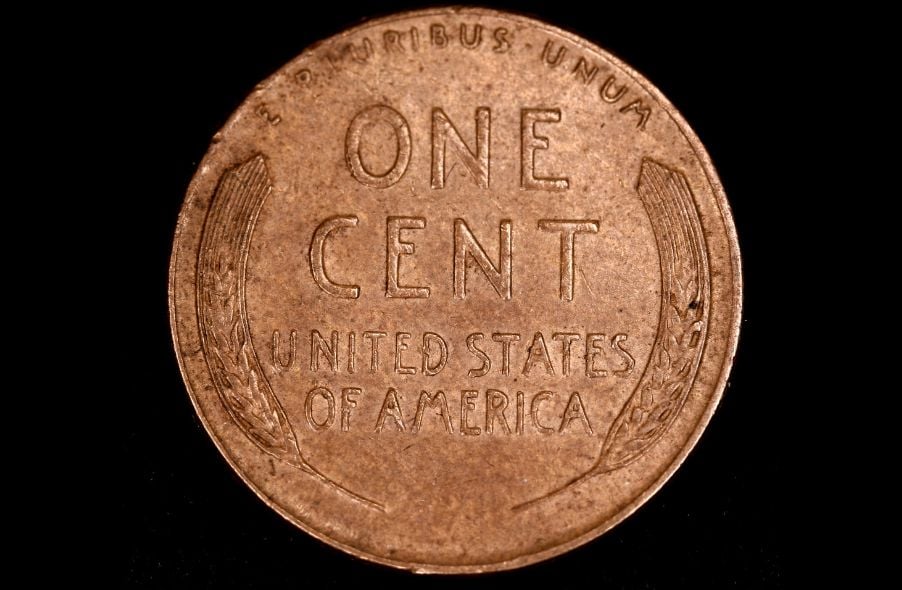#1 1933 Saint Gaudens Double Eagle
The 1933 Saint-Gaudens Double Eagle is a world-famous gold coin minted in the United States between 1907 and 1933. Designed by Augustus Saint-Gaudens, this beautiful coin features an image of Liberty holding an olive branch and a torch, with an eagle in flight on the reverse side. Made of 90% gold and 10% copper, it contains .96750 troy oz of gold. Originally worth $20, today it is valued at over $20,000,000!
#2 1913 Liberty Head Nickel
The 1913 Liberty Head Nickel is an extremely rare coin with only five specimens known to exist. It features Liberty's head on the front and the letter "V" on the reverse side. Originally, these coins belonged to Samuel Brown, a numismatist who sold them in 1924. However, they ended up in the collection of Colonel E. H. R. Green until his passing in 1936, when two coin dealers split the set. Despite its original face value of five cents, it is now estimated to be worth over $5,000,000.
#3 1787 Brasher Doubloon
The 1787 Brasher Doubloon is an extremely rare coin and holds tremendous historical value. It was the first-ever gold coin produced in the United States before federal mints existed. Only seven specimens of the original coin exist, all created by Ephraim Brasher, a goldsmith and neighbor of George Washington. A Brasher Doubloon contains 26.6 grams of 22-carat gold and was priced at $15 at the time of its production. Today, it is worth over $10,000,000.
#4 1943 Lincoln Head Copper Penny
The 1943 Lincoln Head Copper Penny is a unique coin minted during World War II. Nickel and copper were scarce at the time, so almost all 1943 pennies were steel coins. However, the mint accidentally used copper for one random batch of pennies. Only around 20 to 40 of the original 1943 Lincoln Head Copper Pennies still exist, with most worth several hundred thousand dollars. In 2010, one coin was sold for $1,750,000, equivalent to over $2,300,000 today!
#5 Flowing Hair Silver Dollar
The Flowing Hair Silver Dollar, minted between 1794 and 1795, was the first silver U.S. dollar. In 2010, one of the earliest 1794 specimens sold for over $10,000,000, making it the world's most expensive coin at the time. The coin weighs 26.96 grams and consists of 90% silver and 10% copper. It features the bust of Liberty on the front and an eagle surrounded by a wreath on the reverse side.
#6 723 Umayyad Gold Dinar
The 723 Umayyad Gold Dinar is an ancient coin from 723 AD and ranks among the most valuable coins in the world. Approximately a dozen specimens of this rare Islamic coin exist, with one fetching approximately $5,400,000 today. The coin dates from the time of Yazid II, an Umayyad caliph, and features intricate inscriptions referring to a mine northwest of Mecca, giving the coin significant historical importance. It is the earliest Islamic coin to mention a place in today's Kingdom of Saudi Arabia.
#7 2007 Canadian Gold Maple Leaf
The 2007 Canadian Gold Maple Leaf, also known as the Big Maple Leaf, is a novelty coin minted in Canada. Weighing 100 kilograms and made of 999.99 pure gold, it was the largest coin in the world until the one-ton Australian Kangaroo appeared in 2011. Six Big Maple Leafs exist, each worth over $5,300,000. The coin features an image of Queen Elizabeth II and a suitably intricate maple leaf design.
#8 1928 China Silver Dollar, Year 17
The 1928 China Silver Dollar, Year 17, is a rare Chinese silver dollar with historical significance. It sold for $2,160,000 at an auction in 2021 and continues to generate interest among collectors. The obverse side of the coin depicts Chang Tso-lin, a warlord who dominated Manchuria between 1916 and 1928. The reverse side shows two crossed flags: one of the Republic of China and the other of the Wuchang Uprising.
#9 1787 Fugio Cent
The 1787 Fugio Cent, also known as the Franklin cent, was the first coin circulated in the United States. Made of copper, it features a sundial under a sun next to the Latin word "fugio," conveying the message that "time flies." The
Frequently Asked Questions
How can you withdraw from an IRA of Precious Metals?
First, determine if you would like to withdraw money directly from an IRA. Make sure you have enough cash in your account to cover any fees, penalties, or charges that may be associated with withdrawing money from an IRA.
Consider opening a taxable brokerage instead of an IRA if it is possible to pay a penalty if your withdrawal is made before the deadline. This option will require you to pay taxes on the amount that you withdraw.
Next, calculate how much money your IRA will allow you to withdraw. This calculation is dependent on several factors like your age when you take the money out, how long you have had the account, and whether or not your plan to continue contributing.
Once you have an idea of the amount of your total savings you wish to convert into cash you will need to decide what type of IRA you want. While traditional IRAs are tax-free, Roth IRAs can be withdrawn at any time after you reach 59 1/2. However, Roth IRAs will charge income taxes upfront and allow you to access your earnings later without additional taxes.
Finally, you'll need to open a brokerage account once these calculations are completed. Brokers often offer promotional offers and signup bonuses to encourage people into opening accounts. It is better to open an account with a debit than a creditcard in order to avoid any unnecessary fees.
When it's time to make withdrawals from your precious-metal IRA, you'll need a place to keep your coins safe. Some storage facilities will take bullion bars while others require you only to purchase individual coins. Before you choose one, weigh the pros and cons.
Bullion bars require less space, as they don't contain individual coins. However, each coin will need to be counted individually. However, you can easily track the value of individual coins by storing them in separate containers.
Some people like to keep their coins in vaults. Some people prefer to store their coins safely in a vault. No matter what method you use, it is important to keep your bullion safe so that you can reap its benefits for many more years.
How does a gold IRA work?
The Gold Ira Accounts are tax-free investment options for those who want to make investments in precious metals.
Physical gold bullion coin can be purchased at any time. You don’t have to wait to begin investing in gold.
You can keep gold in an IRA forever. You won't have to pay taxes on your gold investments when you die.
Your heirs will inherit your gold, and not pay capital gains taxes. It is not required that you include your gold in the final estate report because it remains outside your estate.
To open a Gold IRA, you'll need to first set up an Individual Retirement Account (IRA). After you have done this, an IRA custodian will be assigned to you. This company acts as a middleman between you and the IRS.
Your gold IRA custodian can handle all paperwork and submit necessary forms to IRS. This includes filing annual returns.
Once you've established your gold IRA, you'll be able to purchase gold bullion coins. The minimum deposit required to purchase gold bullion coins is $1,000 The minimum deposit is $1,000. However, you will receive a higher percentage of interest if your deposit is greater.
Taxes will apply to gold that you take out of an IRA. If you're withdrawing the entire balance, you'll owe income taxes plus a 10 percent penalty.
However, if you only take out a small percentage, you may not have to pay taxes. However, there are some exceptions. You'll owe federal income tax and a 20% penalty if you take out more than 30% of your total IRA assets.
You should avoid taking out more than 50% of your total IRA assets yearly. You could end up with severe financial consequences.
What is the best precious metal to invest in?
Answering this question will depend on your willingness to take some risk and the return you seek. Gold is a traditional haven investment. However, it is not always the most profitable. For example, if your goal is to make quick money, gold may not suit you. If you have time and patience, you should consider investing in silver instead.
If you don’t desire to become rich quickly, gold may be your best option. If you want to invest in long-term, steady returns, silver is a better choice.
How much money should I put into my Roth IRA?
Roth IRAs let you save tax on retirement by allowing you to deposit your own money. These accounts are not allowed to be withdrawn before the age of 59 1/2. If you decide to withdraw some of your contributions, you will need to follow certain rules. First, your principal (the deposit amount originally made) is not transferable. This means that no matter how much you contribute, you can never take out more than what was initially contributed to this account. If you wish to withdraw more than you originally contributed, you will have to pay taxes.
The second rule says that you cannot withdraw your earnings without paying income tax. So, when you withdraw, you'll pay taxes on those earnings. For example, let's say that you contribute $5,000 to your Roth IRA every year. Let's also say that you earn $10,000 per annum after contributing. Federal income taxes would apply to the earnings. You would be responsible for $3500 The remaining $6,500 is yours. The amount you can withdraw is limited to the original contribution.
You would still owe tax on $1,500 if you took out $4,000 of your earnings. You would also lose half of your earnings because they are subject to another 50% tax (half off 40%). Even though you had $7,000 in your Roth IRA account, you only received $4,000.
There are two types if Roth IRAs, Roth and Traditional. Traditional IRAs allow pre-tax contributions to be deducted from your taxable tax income. When you retire, you can use your traditional IRA to withdraw your contribution balance plus interest. There are no restrictions on the amount you can withdraw from a Traditional IRA.
Roth IRAs don't allow you deduct contributions. After you have retired, the full amount of your contributions and accrued interest can be withdrawn. There is no minimum withdrawal required, unlike a traditional IRA. You don't need to wait until your 70 1/2 year old age before you can withdraw your contribution.
Are You Ready to Invest in Gold?
The answer will depend on how many dollars you have saved so far and whether you had gold as an investment option at the time. If you're unsure about which option to choose then consider investing in both.
Gold is a safe investment and can also offer potential returns. Retirement investors will find gold a worthy investment.
Gold is more volatile than most other investments. Because of this, gold's value can fluctuate over time.
This doesn't mean that you should not invest in gold. It is important to consider the fluctuations when planning your portfolio.
Another advantage of gold is its tangible nature. Gold can be stored more easily than stocks and bonds. It's also portable.
As long as you keep your gold in a secure location, you can always access it. Plus, there are no storage fees associated with holding physical gold.
Investing in gold can help protect against inflation. Gold prices are likely to rise with other commodities so it is a good way of protecting against rising costs.
It's also a good idea to have a portion your savings invested in something which isn't losing value. Gold usually rises when stocks fall.
Investing in gold has another advantage: you can sell it anytime you want. You can easily liquidate your investment, just as with stocks. You don't even need to wait for your retirement.
If you do decide to invest in gold, make sure to diversify your holdings. Don't place all your eggs in the same basket.
Don't buy too many at once. Start by purchasing a few ounces. Continue adding more as necessary.
It's not about getting rich fast. It's not to get rich quickly, but to accumulate enough wealth to no longer need Social Security benefits.
Gold may not be the most attractive investment, but it could be a great complement to any retirement strategy.
Statistics
- This is a 15% margin that has shown no stable direction of growth but fluctuates seemingly at random. (smartasset.com)
- Instead, the economy improved, stocks rebounded, and gold plunged, losing 28 percent of its value in 2013. (aarp.org)
- Indeed, several financial advisers interviewed for this article suggest you invest 5 to 15 percent of your portfolio in gold, just in case. (aarp.org)
- If you accidentally make an improper transaction, the IRS will disallow it and count it as a withdrawal, so you would owe income tax on the item's value and, if you are younger than 59 ½, an additional 10% early withdrawal penalty. (forbes.com)
- The price of gold jumped 131 percent from late 2007 to September 2011, when it hit a high of $1,921 an ounce, according to the World Gold Council. (aarp.org)
External Links
forbes.com
- Gold IRA: Add Some Sparkle To Your Retirement Nest Egg
- Understanding China's Evergrande Crisis – Forbes Advisor
bbb.org
law.cornell.edu
- 7 U.S. Code SS7 – Designation Boards of Trade as Contract Markets
- 26 U.S. Code SS 408 – Individual retirement funds
irs.gov
How To
The History of Gold as an Asset
From the beginning of history, gold was a popular currency. It was popular because of its purity, divisibility. uniformity. scarcity and beauty. In addition, because of its value, it was traded internationally. Because there were no internationally recognized standards for measuring and weighing gold, the different weights of this metal could be used worldwide. One pound sterling, for example, was equivalent in England to 24 carats, and one livre tournois, in France, to 25 carats. A mark, on the other hand, was equivalent in Germany to 28 carats.
The United States started issuing American coins in the 1860s made of 90% copper and 10% zinc. This caused a drop in foreign currency demand which resulted in an increase of their prices. The price of gold dropped because the United States began to mint large quantities of gold coins. Due to the excessive amount of money flowing into the United States, they had to find a way for them to repay some of their debt. To do this, they decided that some of their excess gold would be sold back to Europe.
Many European countries didn't trust the U.S. dollars and started to accept gold for payment. However, after World War I, many European countries stopped taking gold and began using paper money instead. The price of gold rose significantly over the years. Even though the price of gold fluctuates, it remains one the best investments you can make.
—————————————————————————————————————————————————————————————-
By: Learn About Gold
Title: The Most Valuable Coins in the World: A Collector's Dream
Sourced From: learnaboutgold.com/blog/most-valuable-coins-to-collect/
Published Date: Sat, 18 Nov 2023 17:55:02 +0000















